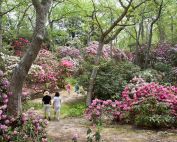The Looff Carousel
Heritage Museums & Gardens owns an original 1908 Looff carousel made in East Providence, RI. Charles I. D. Looff was a master carver and builder of hand-carved carousels and amusement rides in America. Born in Denmark in 1852 and immigrating to America in 1870, Looff built the first carousel at Coney Island in 1876. Looff manufactured over 50 carousels, several amusements parks, many roller coasters and Ferris wheels, and built California’s famous Santa Monica Pier. He became famous for creating the unique Coney Island style of carousel carving.
The carousel was purchased from the Looff factory in East Providence, RI for an amusement park in Meridian, Mississippi. In the 1950s the carousel was offered for sale when the park closed, and it was purchased by an amusement ride dealer. This dealer eventually sold the figures and chariots to a middleman, who placed an advertisement for them in the fall 1965 edition of Amusement News. Hallet Tobin of Provincetown saw the ad, and drove to Washington, D.C. to purchase the figures. He then purchased a platform for the carousel (the previous one had been stored outside and had rotted beyond use), and planned to erect the carousel in Provincetown. However, the town would not allow this so he sold the carousel to Mr. Lilly for the museum. The museum’s collection also includes a dozen menagerie figures by other carvers. Most notably, there are two figures carved by one of the best carousel carvers, Salvatore Cernigliaro, who made the flirting rabbit and cat. The collection also includes a deer, ostrich, tiger, pig, giraffe, camel, frog, tiger, lion, burro, bear, and zebra.
Fast Facts
- Any animals on a carousel other than horses are called menagerie figures. A menagerie refers to a collection of wild or unusual animals kept for exhibition.
- Carvers adorned carousel figures with fancy saddles, jewels, and other special carvings called trappings. The trappings were most elaborate on the outside row of animals and on the side of the animals facing outward. The right side of American carousel figures is called the “fancy side” or the “romance side.”
- Most American carousel figures are made out of basswood or poplar. These are considered hardwoods and also very good carving woods.
- Carousel figures’ bodies are constructed like a box. They are hollow on the inside and are made up of 2,550 individual pieces of wood, assembled using a combination of wooden dowels and hot glue.
- Animals that have two or more legs on the carousel platform and do not move up and down are called “standers.” “Jumpers” are animals that move up and down as the carousel turns. Jumpers were first introduced in 1905.
- A carousel horse’s tail is either carved out of wood at the factory or made from a real horse’s tail. Heritage’s carousel horses have horse hair tails, favored by Looff for the sense of motion they added.
- Most of the special music heard while riding a carousel comes from a self-playing musical instrument known as a band organ.
- Patriotic trappings, such as American flags and eagles, were often incorporated into figures crafted by the many immigrant carvers who helped create America’s wooden carousels.
- Carousels typically had two riding benches called chariots for those who did not want to ride on an animal (including ladies who did not wish to ride side saddle in their long skirts as would have been customary).
- On the majority of carousels, there is one figure that stands out above the others. The carved trappings are usually fancier on this “lead” horse. This helped the operator count the number of times the carousel went around during each ride.
- The oldest horses on this carousel were carved in the 1880s and have checkered blankets under their saddles.
- The antlers on the deer figure, as on most carousel deer, are real. Actual antlers were both simpler to install and more durable than carved antlers.
- Some carousel advertisements in early nineteenth century America stated that the ride was highly recommended by physicians as an aid to circulating the blood.
- Carousel figures weigh between 60-190 pounds.
- In America carousels travel counterclockwise while in England they travel clockwise.
- The best carvers were able to produce an outside-row carousel figure from start to finish in fewer than 40 hours.











